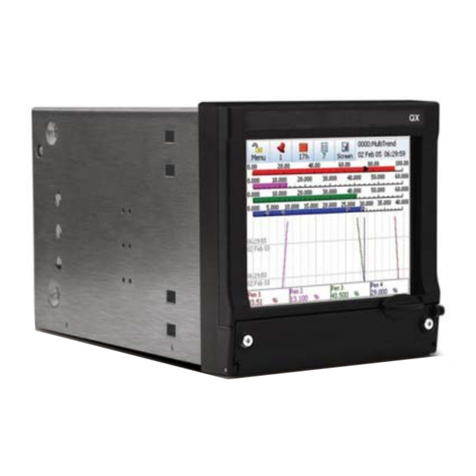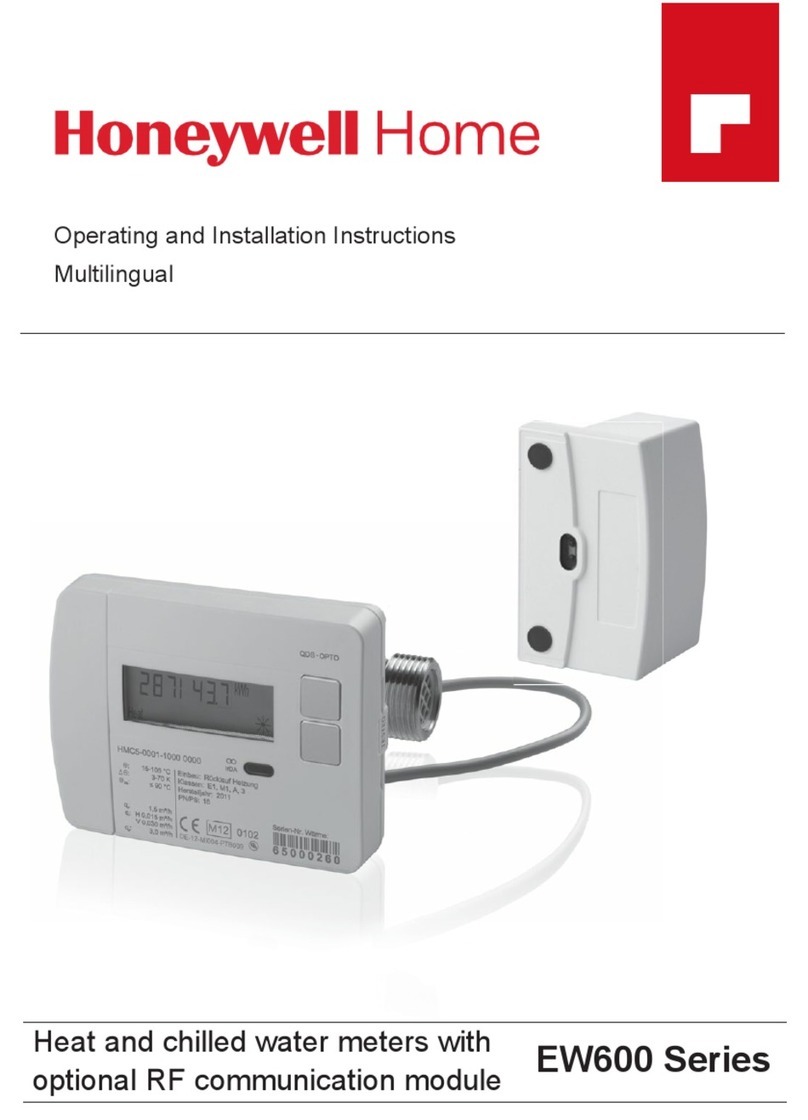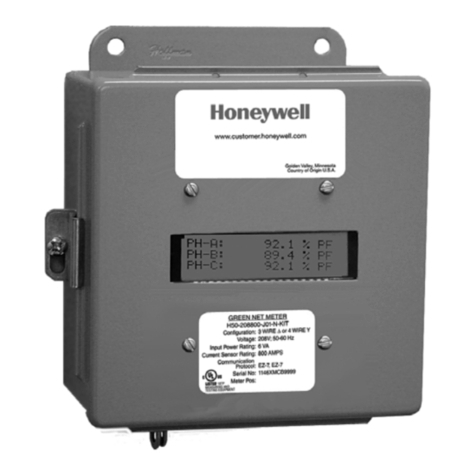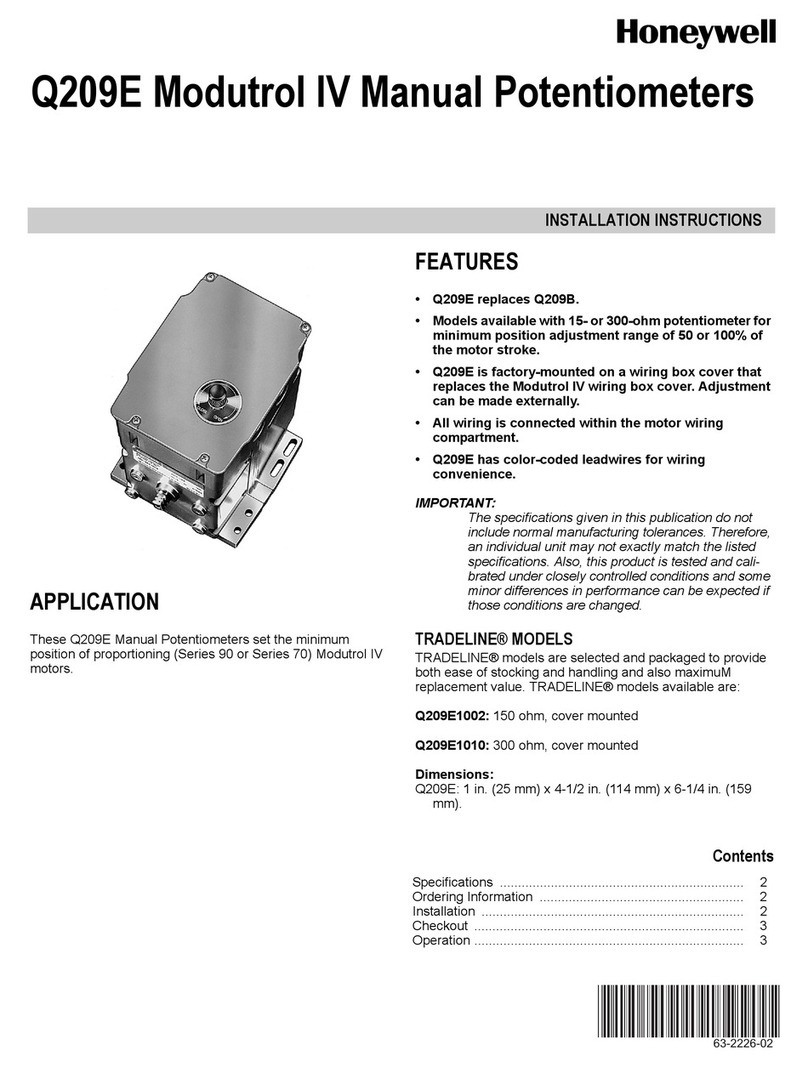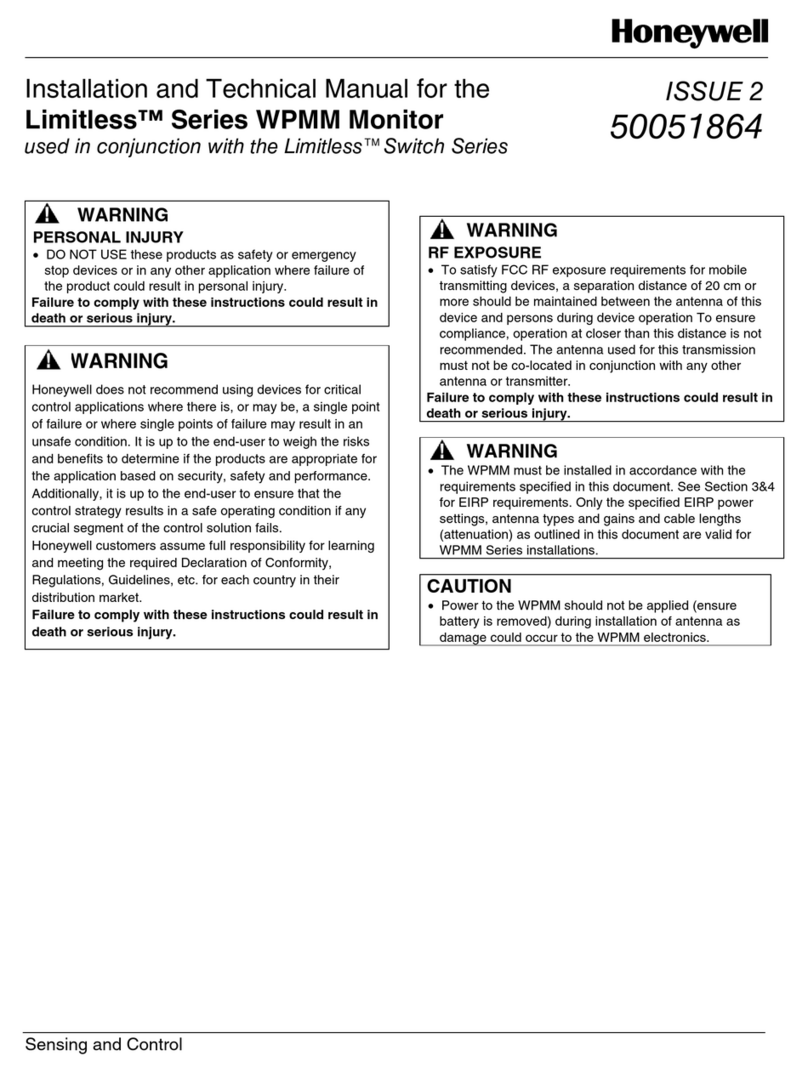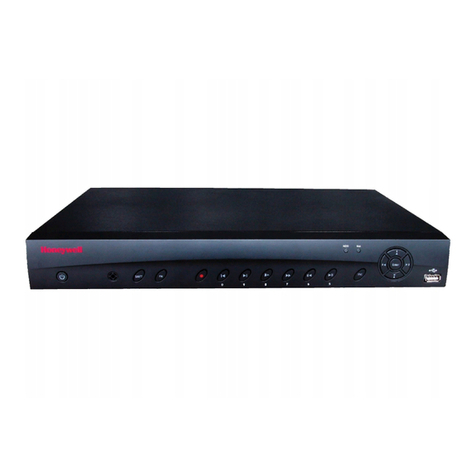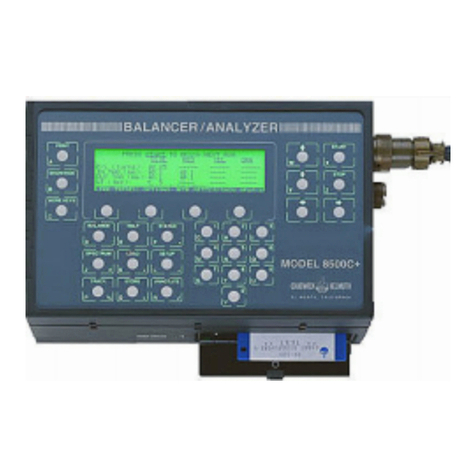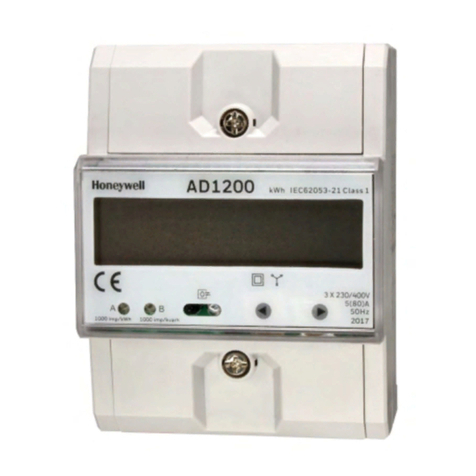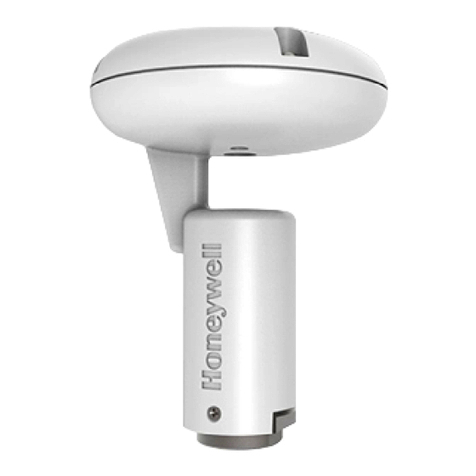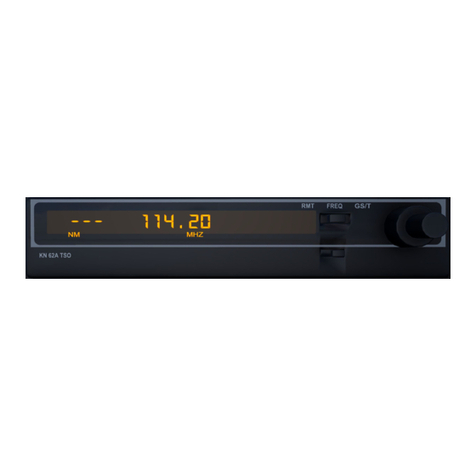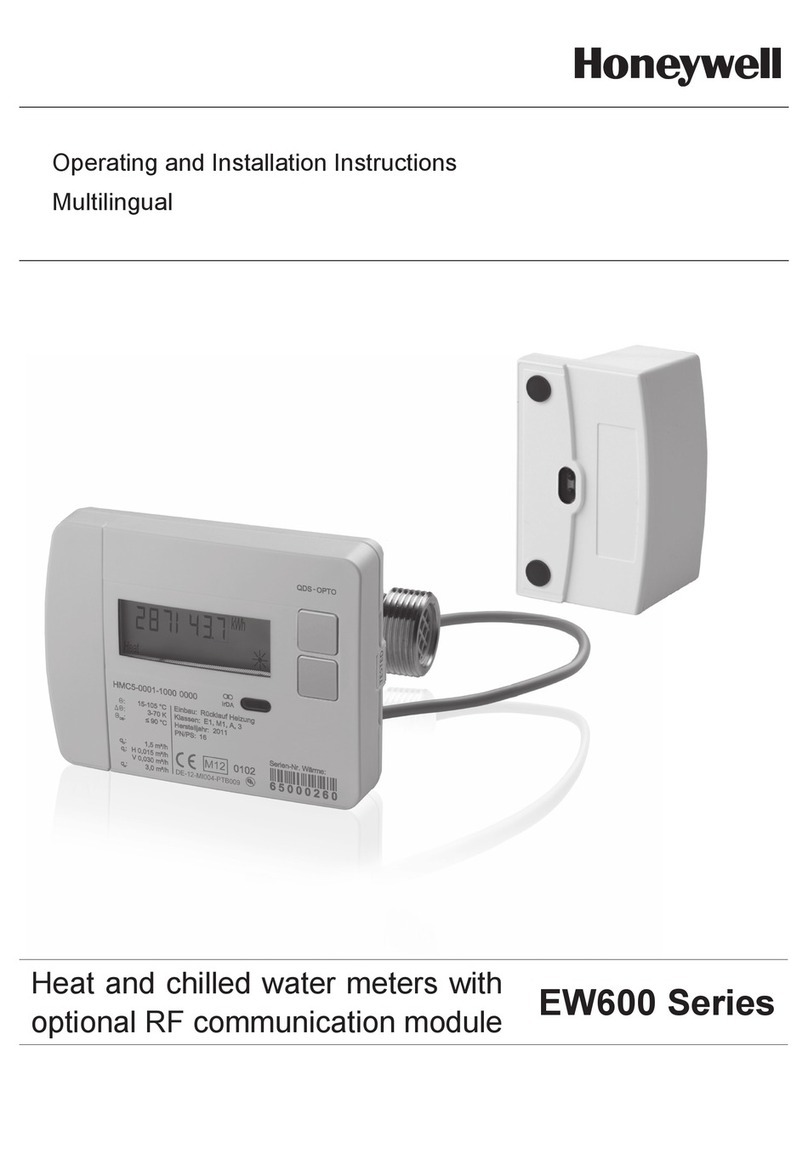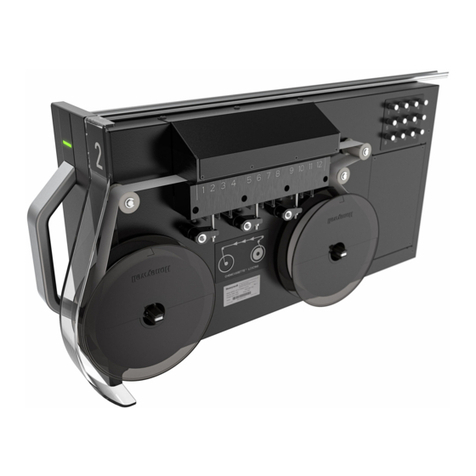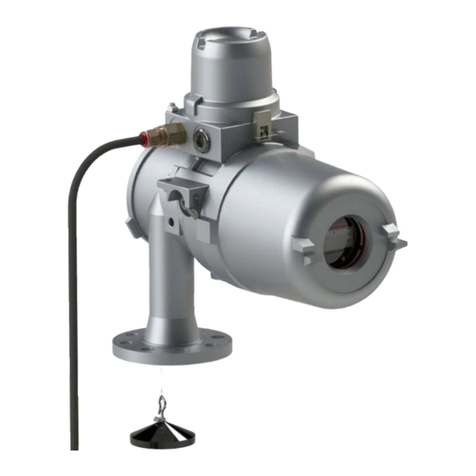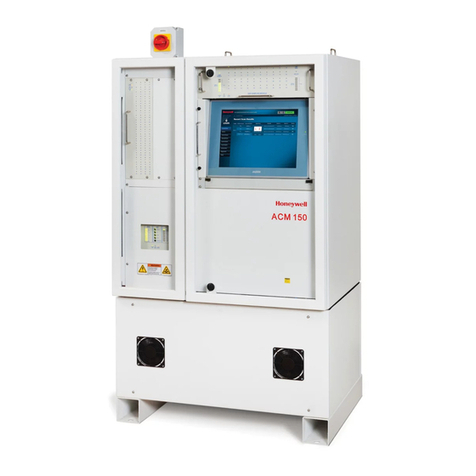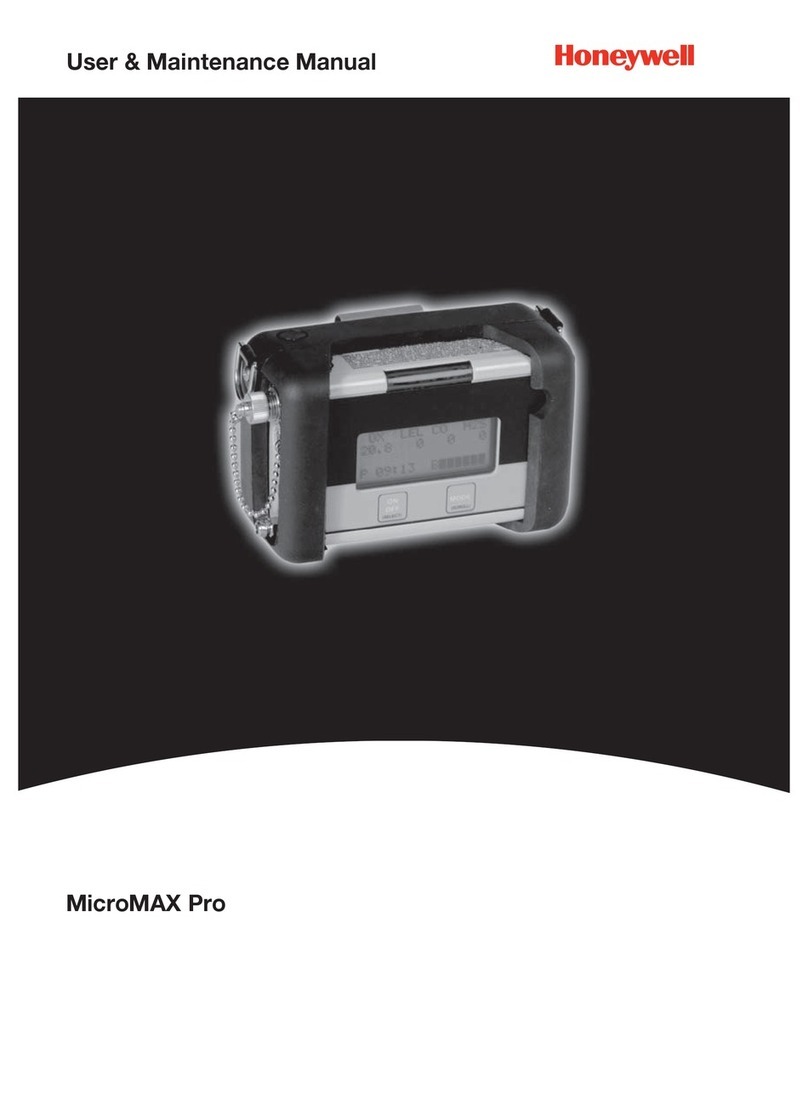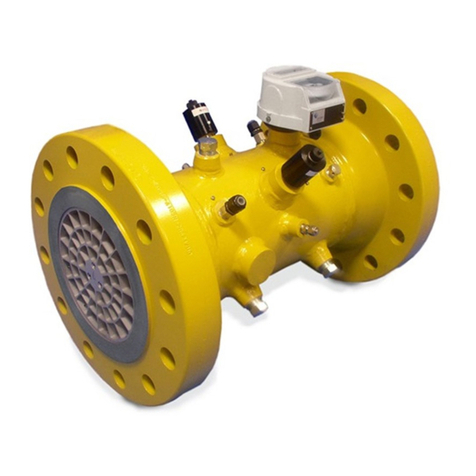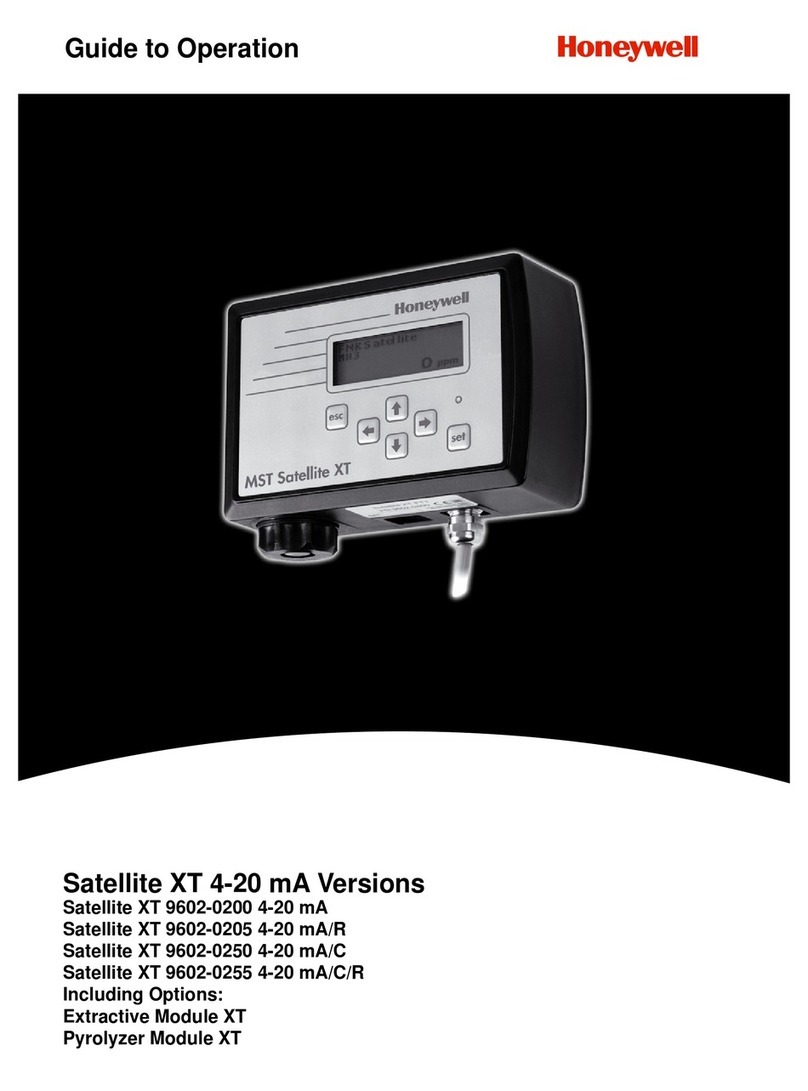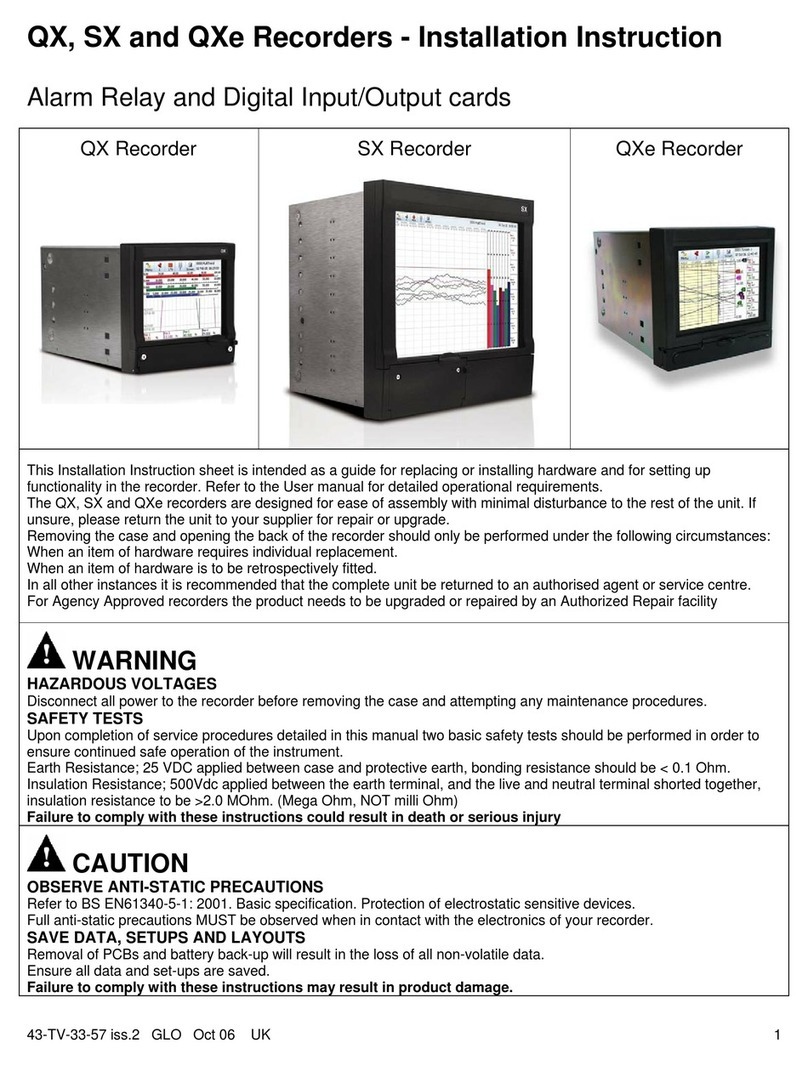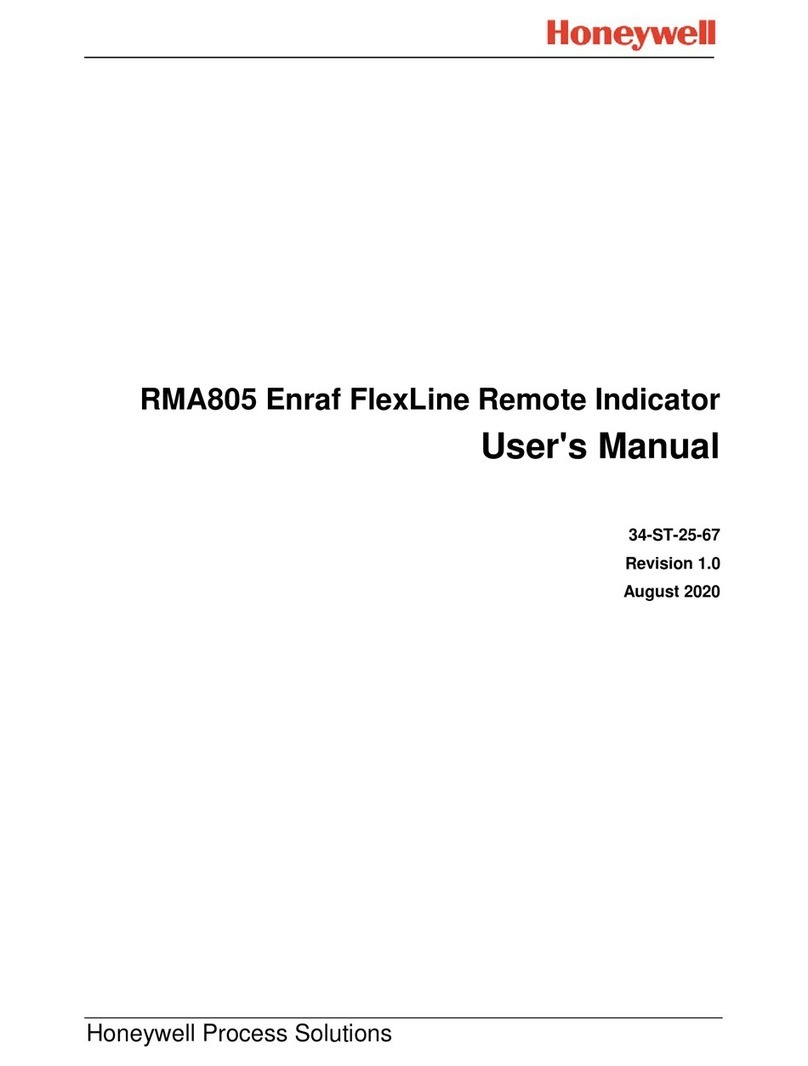
ELSTER RABO® Rotary Gas Meter 04 Honeywell
RABO® Rotary Gas Meter 03 Elster Instromet
4. Receiving, Handling and Storage
Elster RABO meters should be handled with care to protect the
product from damage. If the package shows evidence of damage
through mishandling in transit, you should notify the shipper
immediately, file a claim with the carrier and notify your Elster
supplier.
Damage to internal components may occur without visible
external damage. All new meters should be inspected and
checked for free rotation of the impellers by lightly blowing
into the inlet of the meter. This slight air pressure should
cause the impellers to rotate freely and come to a stop slowly.
NOTICE
DO NOT attempt to make any repairs. Tampering with the
meter may void warranty coverage.
If a meter shows signs of external damage, or if the impellers do
not rotate freely, contact your local Elster sales representative for
return instructions.
Elster RABO meters are supplied with oil in a separate container.
A material safety data sheet (MSDS) is available upon request. DO
NOT put oil in the meter until it is installed and leveled in the gas
piping system. Meters containing oil that are transported or not
installed level may lead to contamination of the measurement
chamber, and will impact accuracy.
Store Elster RABO meters in their original shipping container in a
dry location until installation. If prolonged storage is experienced,
RABO meters should be tested for accuracy before installation.
5. Installation
Elster RABO meters can be installed in horizontal or vertical (top
inlet) piping configurations. Vertical (top inlet) piping is preferred
because it enables the meter to pass contaminants more freely
through the meter. All piping should be properly supported
and aligned to eliminate any strain on the meter, which may cause
the impellers to bind.
Recommended piping practices include a filter or strainer on the
inlet of the meter and non-lubricated isolation valves. A bypass
line will facilitate maintenance and removal of the meter and
provide uninterrupted gas supply.
The meter should not be installed lower than the outlet pipe run.
If it is necessary to install the meter lower than the outlet pipe run,
installation of a drip leg in the outlet piping to capture condensate
is recommended. The meter should never be located at the lowest
point in the system.
A restricting orifice can also be installed at least 4 pipe diameters
downstream of the outlet of the meter to prevent the meter from
flowing excess capacity. Warranty does not cover failures due to
excess flow conditions.
Figure 2. Horizontal installation, side view
Figure 3. Vertical installation, side view
a) Piping Configurations [Figures 2, 3 and 4]
DO NOT weld piping while meter is installed in the
piping system.
If hydro testing, remove the meter from the piping system.
NOTICE
NOTICE
RABO® Rotary Gas Meter 03 Elster Instromet
4. Receiving, Handling and Storage
Elster RABO meters should be handled with care to protect the
product from damage. If the package shows evidence of damage
through mishandling in transit, you should notify the shipper
immediately, file a claim with the carrier and notify your Elster
supplier.
Damage to internal components may occur without visible
external damage. All new meters should be inspected and
checked for free rotation of the impellers by lightly blowing
into the inlet of the meter. This slight air pressure should
cause the impellers to rotate freely and come to a stop slowly.
NOTICE
DO NOT attempt to make any repairs. Tampering with the
meter may void warranty coverage.
If a meter shows signs of external damage, or if the impellers do
not rotate freely, contact your local Elster sales representative for
return instructions.
Elster RABO meters are supplied with oil in a separate container.
A material safety data sheet (MSDS) is available upon request. DO
NOT put oil in the meter until it is installed and leveled in the gas
piping system. Meters containing oil that are transported or not
installed level may lead to contamination of the measurement
chamber, and will impact accuracy.
Store Elster RABO meters in their original shipping container in a
dry location until installation. If prolonged storage is experienced,
RABO meters should be tested for accuracy before installation.
5. Installation
Elster RABO meters can be installed in horizontal or vertical (top
inlet) piping configurations. Vertical (top inlet) piping is preferred
because it enables the meter to pass contaminants more freely
through the meter. All piping should be properly supported
and aligned to eliminate any strain on the meter, which may cause
the impellers to bind.
Recommended piping practices include a filter or strainer on the
inlet of the meter and non-lubricated isolation valves. A bypass
line will facilitate maintenance and removal of the meter and
provide uninterrupted gas supply.
The meter should not be installed lower than the outlet pipe run.
If it is necessary to install the meter lower than the outlet pipe run,
installation of a drip leg in the outlet piping to capture condensate
is recommended. The meter should never be located at the lowest
point in the system.
A restricting orifice can also be installed at least 4 pipe diameters
downstream of the outlet of the meter to prevent the meter from
flowing excess capacity. Warranty does not cover failures due to
excess flow conditions.
Figure 2. Horizontal installation, side view
Figure 3. Vertical installation, side view
a) Piping Configurations [Figures 2, 3 and 4]
DO NOT weld piping while meter is installed in the
piping system.
If hydro testing, remove the meter from the piping system.
NOTICE
NOTICE
RABO® Rotary Gas Meter 03 Elster Instromet
4. Receiving, Handling and Storage
Elster RABO meters should be handled with care to protect the
product from damage. If the package shows evidence of damage
through mishandling in transit, you should notify the shipper
immediately, file a claim with the carrier and notify your Elster
supplier.
Damage to internal components may occur without visible
external damage. All new meters should be inspected and
checked for free rotation of the impellers by lightly blowing
into the inlet of the meter. This slight air pressure should
cause the impellers to rotate freely and come to a stop slowly.
NOTICE
DO NOT attempt to make any repairs. Tampering with the
meter may void warranty coverage.
If a meter shows signs of external damage, or if the impellers do
not rotate freely, contact your local Elster sales representative for
return instructions.
Elster RABO meters are supplied with oil in a separate container.
A material safety data sheet (MSDS) is available upon request. DO
NOT put oil in the meter until it is installed and leveled in the gas
piping system. Meters containing oil that are transported or not
installed level may lead to contamination of the measurement
chamber, and will impact accuracy.
Store Elster RABO meters in their original shipping container in a
dry location until installation. If prolonged storage is experienced,
RABO meters should be tested for accuracy before installation.
5. Installation
Elster RABO meters can be installed in horizontal or vertical (top
inlet) piping configurations. Vertical (top inlet) piping is preferred
because it enables the meter to pass contaminants more freely
through the meter. All piping should be properly supported
and aligned to eliminate any strain on the meter, which may cause
the impellers to bind.
Recommended piping practices include a filter or strainer on the
inlet of the meter and non-lubricated isolation valves. A bypass
line will facilitate maintenance and removal of the meter and
provide uninterrupted gas supply.
The meter should not be installed lower than the outlet pipe run.
If it is necessary to install the meter lower than the outlet pipe run,
installation of a drip leg in the outlet piping to capture condensate
is recommended. The meter should never be located at the lowest
point in the system.
A restricting orifice can also be installed at least 4 pipe diameters
downstream of the outlet of the meter to prevent the meter from
flowing excess capacity. Warranty does not cover failures due to
excess flow conditions.
Figure 2. Horizontal installation, side view
Figure 3. Vertical installation, side view
a) Piping Configurations [Figures 2, 3 and 4]
DO NOT weld piping while meter is installed in the
piping system.
If hydro testing, remove the meter from the piping system.
NOTICE
NOTICE
RABO® Rotary Gas Meter 03 Elster Instromet
4. Receiving, Handling and Storage
Elster RABO meters should be handled with care to protect the
product from damage. If the package shows evidence of damage
through mishandling in transit, you should notify the shipper
immediately, file a claim with the carrier and notify your Elster
supplier.
Damage to internal components may occur without visible
external damage. All new meters should be inspected and
checked for free rotation of the impellers by lightly blowing
into the inlet of the meter. This slight air pressure should
cause the impellers to rotate freely and come to a stop slowly.
NOTICE
DO NOT attempt to make any repairs. Tampering with the
meter may void warranty coverage.
If a meter shows signs of external damage, or if the impellers do
not rotate freely, contact your local Elster sales representative for
return instructions.
Elster RABO meters are supplied with oil in a separate container.
A material safety data sheet (MSDS) is available upon request. DO
NOT put oil in the meter until it is installed and leveled in the gas
piping system. Meters containing oil that are transported or not
installed level may lead to contamination of the measurement
chamber, and will impact accuracy.
Store Elster RABO meters in their original shipping container in a
dry location until installation. If prolonged storage is experienced,
RABO meters should be tested for accuracy before installation.
5. Installation
Elster RABO meters can be installed in horizontal or vertical (top
inlet) piping configurations. Vertical (top inlet) piping is preferred
because it enables the meter to pass contaminants more freely
through the meter. All piping should be properly supported
and aligned to eliminate any strain on the meter, which may cause
the impellers to bind.
Recommended piping practices include a filter or strainer on the
inlet of the meter and non-lubricated isolation valves. A bypass
line will facilitate maintenance and removal of the meter and
provide uninterrupted gas supply.
The meter should not be installed lower than the outlet pipe run.
If it is necessary to install the meter lower than the outlet pipe run,
installation of a drip leg in the outlet piping to capture condensate
is recommended. The meter should never be located at the lowest
point in the system.
A restricting orifice can also be installed at least 4 pipe diameters
downstream of the outlet of the meter to prevent the meter from
flowing excess capacity. Warranty does not cover failures due to
excess flow conditions.
Figure 2. Horizontal installation, side view
Figure 3. Vertical installation, side view
a) Piping Configurations [Figures 2, 3 and 4]
DO NOT weld piping while meter is installed in the
piping system.
If hydro testing, remove the meter from the piping system.
NOTICE
NOTICE
RABO® Rotary Gas Meter 03 Elster Instromet
4. Receiving, Handling and Storage
Elster RABO meters should be handled with care to protect the
product from damage. If the package shows evidence of damage
through mishandling in transit, you should notify the shipper
immediately, file a claim with the carrier and notify your Elster
supplier.
Damage to internal components may occur without visible
external damage. All new meters should be inspected and
checked for free rotation of the impellers by lightly blowing
into the inlet of the meter. This slight air pressure should
cause the impellers to rotate freely and come to a stop slowly.
NOTICE
DO NOT attempt to make any repairs. Tampering with the
meter may void warranty coverage.
If a meter shows signs of external damage, or if the impellers do
not rotate freely, contact your local Elster sales representative for
return instructions.
Elster RABO meters are supplied with oil in a separate container.
A material safety data sheet (MSDS) is available upon request. DO
NOT put oil in the meter until it is installed and leveled in the gas
piping system. Meters containing oil that are transported or not
installed level may lead to contamination of the measurement
chamber, and will impact accuracy.
Store Elster RABO meters in their original shipping container in a
dry location until installation. If prolonged storage is experienced,
RABO meters should be tested for accuracy before installation.
5. Installation
Elster RABO meters can be installed in horizontal or vertical (top
inlet) piping configurations. Vertical (top inlet) piping is preferred
because it enables the meter to pass contaminants more freely
through the meter. All piping should be properly supported
and aligned to eliminate any strain on the meter, which may cause
the impellers to bind.
Recommended piping practices include a filter or strainer on the
inlet of the meter and non-lubricated isolation valves. A bypass
line will facilitate maintenance and removal of the meter and
provide uninterrupted gas supply.
The meter should not be installed lower than the outlet pipe run.
If it is necessary to install the meter lower than the outlet pipe run,
installation of a drip leg in the outlet piping to capture condensate
is recommended. The meter should never be located at the lowest
point in the system.
A restricting orifice can also be installed at least 4 pipe diameters
downstream of the outlet of the meter to prevent the meter from
flowing excess capacity. Warranty does not cover failures due to
excess flow conditions.
Figure 2. Horizontal installation, side view
Figure 3. Vertical installation, side view
a) Piping Configurations [Figures 2, 3 and 4]
DO NOT weld piping while meter is installed in the
piping system.
If hydro testing, remove the meter from the piping system.
NOTICE
NOTICE
4. Receiving, Handling and Storage
5. Installation
a) Piping Configurations [Figures 2, 3 and 4]
Figure 2. Horizontal installation, side view
Figure 3. Vertical installation, side view
Elster RABO meters should be handled with care to protect the
product from damage. If the package shows evidence of damage
through mishandling in transit, you should notify the shipper
immediately, file a claim with the carrier and notify your Elster
supplier.
Damage to internal components may occur without visible
external damage. All new meters should be inspected and
checked for free rotation of the impellers by lightly blowing
into the inlet of the meter. This slight air pressure should
cause the impellers to rotate freely and come to a stop slowly.
DO NOT attempt to make any repairs. Tampering with the
meter may void warranty coverage.
If a meter shows signs of external damage, or if the impellers do
not rotate freely, contact your local Elster sales representative for
return instructions.
Elster RABO meters are supplied with oil in a separate container.
A material safety data sheet (MSDS) is available upon request.DO
NOT put oil in the meter until it is installed and leveled in the gas
piping system. Meters containing oil that are transported or not
installed level may lead to contamination of the measurement
chamber, and will impact accuracy.
Store Elster RABO meters in their original shipping container in a
dry location until installation. If prolonged storage is experienced,
RABO meters should be tested for accuracy before installation.
Elster RABO meters can be installed in horizontal or vertical (top
inlet) piping configurations. Vertical (top inlet) piping is preferred
because it enables the meter to pass contaminants more freely
through the meter. All piping should be properly supported
and aligned to eliminate any strain on the meter, which may cause
the impellers to bind.
Recommended piping practices include a filter or strainer on the
inlet of the meter and non-lubricated isolation valves. A bypass
line will facilitate maintenance and removal of the meter and
provide uninterrupted gas supply.
The meter should not be installed lower than the outlet pipe run.
If it is necessary to install the meter lower than the outlet pipe run,
installation of a drip leg in the outlet piping to capture condensate
is recommended. The meter should never be located at the lowest
point in the system.
A restricting orifice can also be installed at least 4 pipe diameters
downstream of the outlet of the meter to prevent the meter from
flowing excess capacity. Warranty does not cover failures due to
excess flow conditions.
DO NOT weld piping while meter is installed in the
piping system.
If hydro testing, remove the meter from the piping system.
